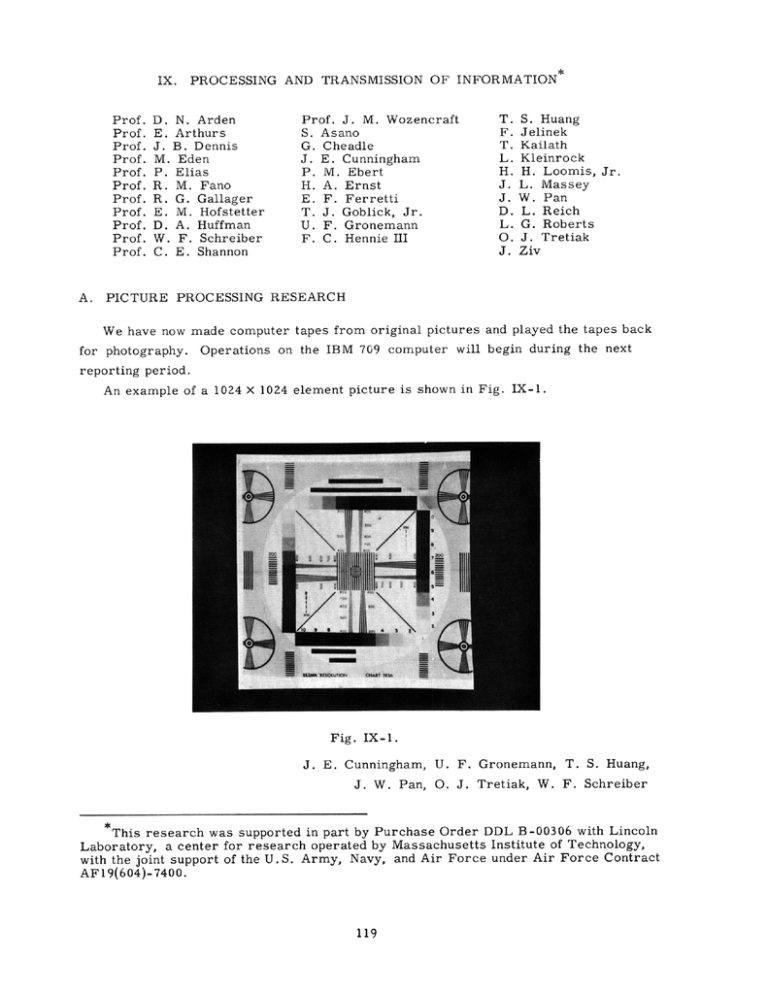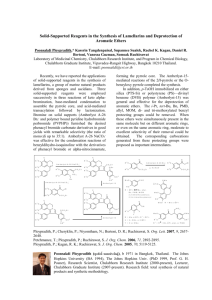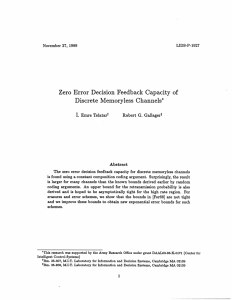S. Huang D. N. Arden Prof. Jelinek
advertisement

IX.
Prof.
Prof.
Prof.
Prof.
Prof.
Prof.
Prof.
Prof.
Prof.
Prof.
Prof.
A.
D.
E.
J.
M.
P.
R.
R.
E.
D.
W.
C.
PROCESSING AND TRANSMISSION OF INFORMATION
N. Arden
Arthurs
B. Dennis
Eden
Elias
M. Fano
G. Gallager
M. Hofstetter
A. Huffman
F. Schreiber
E. Shannon
Prof. J. M. Wozencraft
S. Asano
G. Cheadle
J. E. Cunningham
P. M. Ebert
H. A. Ernst
E. F. Ferretti
T. J. Goblick, Jr.
U. F. Gronemann
F. C. Hennie III
S. Huang
Jelinek
Kailath
Kleinrock
H. Loomis, Jr.
L. Massey
W. Pan
L. Reich
G. Roberts
J. Tretiak
Ziv
PICTURE PROCESSING RESEARCH
We have now made computer tapes from original pictures and played the tapes back
for photography. Operations on the IBM 709 computer will begin during the next
reporting period.
An example of a 1024 X 1024 element picture is shown in Fig. IX-1.
Fig. IX-1.
J. E. Cunningham, U. F. Gronemann, T. S. Huang,
J. W. Pan, O. J. Tretiak, W. F. Schreiber
*This research was supported in part by Purchase Order DDL B-00306 with Lincoln
Laboratory, a center for research operated by Massachusetts Institute of Technology,
with the joint support of the U.S. Army, Navy, and Air Force under Air Force Contract
AF19(604)-7400.
119
(IX.
B.
PROCESSING AND TRANSMISSION OF INFORMATION)
NEW SYSTEMATIC DECODING FOR MEMORYLESS CHANNELS
In this report a sequential decoding scheme for random convolutional codes, which
is to be used for memoryless channels, is described.
The average number of computations does not grow exponentially with n; it is upper-bounded by a quantity proportional
2
to n , for all rates below some cutoff rate R
(n is the block length).
When this decoding scheme is averaged over a suitably defined ensemble of code
words it has an average probability of error with an upper bound whose logarithm is
-nE(R).
E(R) is dependent on the data rate. (E(R) > 0 for rates below channel capacity.)
The decoding scheme is different from other effective decoding schemes such as sequen1
2
tial decoding and low-density parity-check codes. 2
The lower bound on R comp of the systematic decoding scheme that is presented in
this report is the same as the Rcomp of sequential decoding for asymmetric channels.
However,
in the case of sequential decoding, R
subset of code words.
is valid only for the incorrect
comp
The existence of Rcomp for the correct subset has not yet been
established.
Thus, the systematic decoding scheme yields a better bound on the average number
of computations for asymmetric channels. (This is not the case when the channel is symmetric, since the modified sequential decoding scheme after Gallager
S*
*
Fig. IX-2.
3
may be used.)
A convolutional tree code.
A convolutional tree code may be viewed topologically as shown in Fig. IX-2.
The
words are all the directed paths from the input node to the output nodes of the tree (there
are no closed paths). From all nontrivial intermediate nodes there emerge f directed
links, one for each of
I nodes.
Let the number of input symbols per code word be n.
Let the number of input symbols per link be d.
Then the number of links per word is
m = n/d (m is the number of information digits per word).
In Fig. IX-2, n = 6; m = 2;
d= 3; f = 2.
Reiffen 4 has shown that the convolutional codes may be generated sequentially.
1.
The Decoding Procedure
The decoding procedure consists of the following successive operations:
Step 1: The a posteriori probability of each one of the I links of length d that
120
(IX.
PROCESSING AND TRANSMISSION OF INFORMATION)
emerge from the input node to the first k nodes in the tree is computed. The one link
that yields the largest a posteriori probability is chosen to represent the corresponding
part of the transmitted code word.
This detected link connects the input node with one
of the f nodes of the next set of nodes (set I in Fig. IX-3).
The same procedure is then repeated with the detected node of set I as a starting
point. Thus, the a posteriori probability of each one of the f links emerging from the
d
Fig. IX-3.
*
The decoding procedure of step 1.
d
I
IN
I
I
I
T
node that was previously detected, is now computed, and a decision is made.
cedure is then repeated again and again until termination (i. e.,
This pro-
until the detected path
A metric of the form D(u, v) = In P(v/u) is then comL P(v)
Here, P(v/u) is the a posteriori probability of the complete detected word, u,
reaches one of the output nodes).
puted.
and P(v) is the probability of the output symbol v.
If D(u, v) is larger than some preset threshold D o , a final decision is made and the
detection of the first information digit is completed. If D(u, v) < D o , the computation
procedure is then to go to step 2.
Step 2:
The a posteriori probability of each one of the 1
2
links of length 2d that
emerge from the input node to set II (that consist of f2 nodes) is computed (Fig. IX-4).
The one link that yields the largest a posteriori probability is chosen to represent the
corresponding part of the transmitted code word.
The same procedure is then repeated with the detected node of set I as a starting
point, and so on. This procedure is continued until termination (i. e., until the detected
path reaches one of the output nodes).
121
(IX.
PROCESSING AND TRANSMISSION OF INFORMATION)
D(u, v) is then computed for the detected path and compared with the threshold D .
o
If D(u, v) > Do, a final decision is made with respect to the first information digit.
Fig. IX-4.
I
I
I
I
I
I
I
I
I
I
I
I
I
I
I
I
I
I
I
I
I
I
I
I
It
XI
I
If
The decoding procedure of step 2.
I
I
D(u, v) < D O the computation procedure is then to go to step 3.
Step 3:
This step is similar to step 2,
except that the computation length in this
case is 3d, and the number of links involved at each stage is
occurs at step 3,
.
If no termination
the computation procedure then reaches step 4, and so on. Following
the detection of the first information digit, the whole procedure is repeated for the next
digit, and so forth.
a.
The Average Number of Computations per Information Digit
The number of computations that are involved in step 1 is equal to m
number of computations in step 2 is equal to (m.
step 3 is equal to (m.3
2).
.
.
The
The number of computations in
).
In general, the number of computations in step k is
Nk = mfk
Let Ck be the condition that no termination occur at step k.
Step k will be used
only if there were no terminations at all in the previous k - 1 steps.
bility of step k being used is
P(k) = Pr(C1 ,C 2' C2,3 C4.
Ck-)
122
Thus the proba-
(IX.
PROCESSING AND TRANSMISSION OF INFORMATION)
The average number of computations is given by
N = N 1 P(1
)
+ N 2 P(2) + ...
m
+ NkP(k) + ...
NmP(m)
m
(2)
mfkP(k).
NkP(k) = I
k=l
k= 1
=
b.
An Upper Bound on the Average Number of Computations
P(k) may be bounded by
P(k) = Pr(C1, C2 C3 C4 '
Ck-l)
< Pr(Ck- 1 ).
(3)
Thus
m
N=
(m-k+l)
N Pr(Ck-1) =
k= 1
Ik
r(Ck-l1)
(4)
k= 1
Now let uk be the code word detected at step k, and let u be the transmitted code word.
Then
Pr(Ckl) = Pr(D(uk, v).< Do)
= Pr(D(uk' v)
= Pr(D(u, v)
Do;uk=u) + Pr(D(uk, v) 2< Do;Uku)
< Do;uk=u) +Pr(D(uk, v) <- Do;Uk#u)
Thus
Pr(Ckl) The threshold D
0
Pr[D(u,v) <Do] + Pr[uku]
(5)
is set so as to make
Pr[D(u, v)-<DO] <
e
-
(6)
(R)n,
where -E(R) is a function of the rate R.
The number of detected links needed to construct uk is,
Now,
as we have shown, (m-k+1).
u is equal to uk only if all of the (m-k+1) links of uk are equal to the corresponding
links of u.
k-1
links
Let e. be the condition that the a posteriori probability of one of the (f-l)k
1
th
th
node of u is greater or
node of u and not including the (i+l)
emerging from the i
equal to that of the corresponding link of u.
123
Then
(IX.
PROCESSING AND TRANSMISSION OF INFORMATION)
Pr(Uk=U) = Pr(not el; not e 2 ; not e 3 ; ...
Pr(uk*u) = 1 - P r(uk=u) = Pr
U
L i=1
; not e i ...
; not em-k+1)
{ei}.
The probability of the union of events is upper-bounded by the sum of the probabilities of the individual events.
Thus
m-k+ 1
z
Pr(uk*u) -<
Pr(ei )
The rate per symbol is defined as
R
n
In M
1 In
n
m
n
In
/d
1 In
d
where M is the number of code words of length n.
Thus
1
R = - In I
d
(8)
Fano has shown that for a given rate R and a given word length n the probability
of error is bounded by
P(e) < 2 e
E(R) ,
opt(R). n(9)
is the optimum exponent of the average probability of error and is a function of
the rate R.
in the case of Pr(ei), the number of the involved links is (-1)
Now,
jk-1
and the length of each link is kd; thus
1
Rk < -k Ink
k
=-
1
Ink = R
Therefore
Pr(ei) Thus, by Eqs.
2e
-E opt(R)kd
opt
(10)
7 and 10,
< 2m e
P(uk u)
-E
Therefore, by Eqs. 5,
Pr(Ck) < e -
(
opt
(R)kd
(11)
6, and 11,
R)n + 2m e
opt
(12)
124
PROCESSING AND TRANSMISSION OF INFORMATION)
(IX.
Pr(Ck) < 2m eE(R)kd
because,
(13)
as we shall show, by Eq. 21,
Pr(Ck
- 1
<
)
2 me
- E
(R)( k
- 1
E(R) -< E opt(R).
opt
Thus
)d
(14)
The average number of computations, by Eqs. 4 and 14, is therefore bounded by
m
2
N < 2m p
ke-E(R)(k-l)d
(15)
k=l
Now,
R =
(k-1)d
1
(k-l) d
Therefore
= e(k-1)dR.
ek-1
Thus
m
2
2m
1
e(k-1)d[R-E(R)].
(16)
k=
Let R
comp
be the solution of
R = E(R)
Then,
(17)
for all rates below Rcomp, R - E(R) < 0,
N
2m2
and
1
(18)
1_ e[R-E(R)]d
.
The average amount of computations is therefore an algebraic function of m for all
rates below R
comp
c. Evaluation of R
Fano
comp
has shown that
E op t (R
opt
)
= E op t ( 0 )
opt
-
R;
for R < Rit
crit
(19)
for R
(20)
and
opt
opt
.<
crit
R < C.
Let us set D o so as to make E (R) of Eq. 6 equal to
(21)
E(R) = Eopt(0) - Rcomp.
125
PROCESSING AND TRANSMISSION OF INFORMATION)
(IX.
Thus, by Eqs. 12 and 21,
R comp =E opt (O)-R
comp
or
R
comp
2
E
opt
(22)
(0).
Also,
E(R) =E
opt
(O)-R
comp
-
2
E
opt
(0).
(23)
Thus
1
N < 2m 2
S- exp d R-
Eopt(0)
E opt(0) is the zero-rate exponent of the upper bound on the average probability of error
Pe of the same channel, when the optimal decoding scheme is used.
2.
5
The Average Probability of Error
Let u be the transmitted code word.
vector.
Let u' be one of the M(t-1) code words which starts with an information letter
other than that of u.
Pe
Let v be the corresponding channel output
<
The probability of error is bounded by
Pr(D(u, v)
Do) + M(-)Pr(D(u' , v)>Do;D(u, v) >D 0 )
(24)
Thus
Pe
Pr(D(u,v)<Do) + e n R Pr(D(u',v) >D ;D(u,v)>D )
(25)
P (D(u,v)Do) + e n R Pr(D(u ' , v) >D;D(u, v) > D )
(26)
or
Pe
<
Let
P(v/u)
D(u, v) = In
(v)
P(v)
D(u', v) = In
P(v/u')
(v)
where
n
P(v/u) =
-
i=l1
P(yi/xi)
126
(IX.
PROCESSING AND TRANSMISSION OF INFORMATION)
and
n
P(v) = -[ P(Yi )
i=l
P(Yi/xi) is the probability that the output is yi, given that the input symbol x i was
transmitted.
P(x i ) P(Yi/Xi) = P(yi)
X.
Thus
D(u, v)=
di(xi' Yi),'
i=l
where
di(xi, yi) =
P(yi/xi
n P(yi)
)
Thus by the use of the Chernoff Bound,
Pr(D(u, v) < Do)
(
< en G
(s
)-s '(s));
Pr(D(u', v) -< D )-< e n ( y(t)-ty'(t)).;
s < 0
t
0
where
P(x) P(y/x) esd(x, y)
(s) =
xy
x '
s
P(x) P(x') P(y/x) e d( Iy)
y(t) =
xxy
P(x) P(y/x) l + s p(y)-s
p(s) =
xy
and
y(t) =
P(x') P(y)l-t P(y/x')t
x'y
=
P(x) P(y)l-t P(y/x)t
xy
127
PROCESSING AND TRANSMISSION OF INFORMATION)
(IX.
Also,
'(s) = y'(t)
If we let t = 1 + s,
D
no
it can be shown that y'(t) = 9'(t) (also y(t) =
(s)). Thus
- s
Do) - en((s) F'(s))
P (D(u, v)
P (D(u', v)
aD
)
) s
< e n ((
-
+s )
( s' ) ) '
[
where
D
-
1(s)
n
f(s) =
1
P(x) P(y/x)
)
+ s
p(y)-.
xy
Thus
P
e
(27)
< en(4(s)-s '(s))+ en(R+[(s)-(l+s)'(s))
Now, by Eqs. 6 and 23, D o is set so as to get
Pr(D(u, v) < D )< en(4(s
)- s -
=
'(s))
-n(R),
(28)
where
E(R) =
and,
Eopt();
for all R < R
(28a)
comp
as shown by Fano,
E opt(0) = E opt(R)
R=0
xP(x) P(Y/x)
= -n
y
We shall now prove that, once D
2
(28b)
x
is set so as to make -i(s) + s'(s)
SC(S)
= E(R)
:~E(R)
1
Eopt(0),
as in Eq. 28, then
-l(s)
1
+ (i+s) ['(s) > 2 E opt(0).
PROOF:
The minimum of {(2s+l)p'(s)-2i(s)} occurs at that
as [(2s+1) '(s)-2z(s)] =
(2s+l)
(29)
0
'"(s ) + 2F'(s) - 2l'(s) = 0
1
Thus s = - 12
128
s for which
PROCESSING AND TRANSMISSION OF INFORMATION)
(IX.
Also,
since
i"
5
is the variance (see Fano
l(-)
0
0,
2 , (--
s=-1/2
[(1+2s)~(s)-2[(s)]
)
of a random variable.
(30)
[(2s+1)i'(s)-2[i(s) > -24 -.
Now
(y)/2 P(y/x)1/2
P (x)
n=
xy
and therefore
4
1
2
P(x) P(y) 1
= In
/2 p(y/x)l/2
xy
Thus
2
In
24
P(y)1/
If(y)
y
where f(y) =
P(x) P(y/x) 1/ 2.
By the Schwarz inequality,
-J
2
{ f(y) P(y)1/2
<
Y
y
f(y )2 1p(y
Y
)
Thus
2
P(y) 2 7 P(y)
y
y
since
P(y) = 1.
2 (-
1 is. indeed
Thus
a minimum point.
-
Thus s = -.
y
Y
Therefore, by Eq. 28b,
P(x) P(y/x)1/2
In
y
=-E opt(0).
opt
x
Thus -2z(-1) > Eopt(O), and therefore, by Eq. 30,
129
(IX.
PROCESSING AND TRANSMISSION OF INFORMATION)
-[
'(s)i'(s)+(s)
+s)
(s)] > Eopt(0).
E(s)-s
(31)
But, by Eq. 28,
1
-E(R) = t(s) - s4'(s)
Therefore,
2 Eopt(0).
by Eq. 31,
4(s) - (l+s) 4'(s) > -Thus, by Eqs.
27, 28, and 32,
< e
P
(32)
Q.E.D.
Eopt(0)
opt(0)n + en
- Eopt(0)
e
n
P
P
2 e n(R
e
e
<2e
E
(0)
2 Eopt
n(R-R
=
p)
n(R-R comp
n(R-Rcomp
comp
If D o is set so as to minimize the probability of error by making R+ [(s) - (1+s)['(s) =
L(s)- s '(s) = E(R), Shannon 7 has shown that
P
e
-P
2 < -nE(R)
<2e
where E(R) > 0 for R < C, and E(0) >Z E
1
by R comp > -2-E(0)
E()
1
> Ep
E
>4
opt
(0).
However, R
comp
is then lower-bounded
(0).
t(O).
This research was supported in part by a fellowship from the Government of Israel.
J.
Ziv
References
1. J. M. Wozencraft and B. Reiffen, Sequential Decoding (The M.I.T. Press,
Cambridge, Mass., and John Wiley and Sons, Inc., New York, 1961).
2. R. G. Gallager, Low Density Parity Check Codes, Sc.D. Thesis, Department
of Electrical Engineering, M.I.T., September 1960.
3. B. Reiffen, Sequential Encoding and Decoding for the Discrete Memoryless
Channel, Technical Report 374, Research Laboratory of Electronics, M.I.T.; Technical
Report 231, Lincoln Laboratory, M.I.T., August 12, 1960, p. 29.
4.
Ibid.,
see Chapter 2.
5. R. M. Fano, Transmission of Information (The M.I.T. Press, Cambridge,
Mass., and John Wiley and Sons, Inc., New York, 1961), see Chapter 9.
6.
Ibid.,
see Chapter 8; B. Reiffen, oF
7. C. E. Shannon,
report, 1959).
.
cit.,
see Appendix B.
Error Probability Bounds for Noisy Channels (unpublished
130


